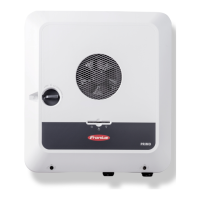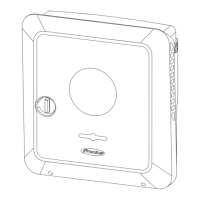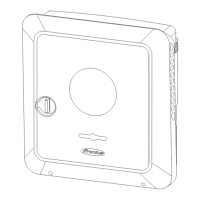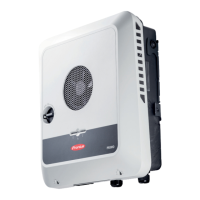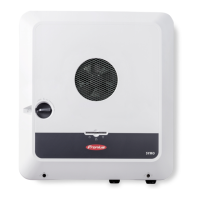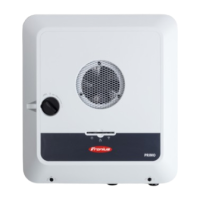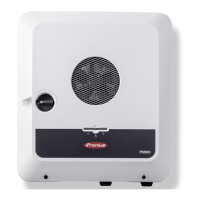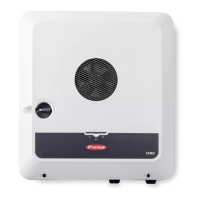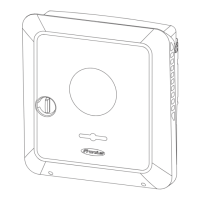Do you have a question about the Fronius Primo GEN24 5.0 Plus and is the answer not in the manual?
Details the meaning of warning symbols and safety instructions.
Covers device safety, qualified personnel, noise, EMC, and environmental conditions.
Addresses user data responsibility and essential protective earthing procedures.
Explains the inverter's core functionality and operational features.
Lists included components and defines the inverter's proper application.
Describes cooling principles and Fronius Solar.web monitoring integration.
Illustrates symbols used to represent different system operating states.
Details various modes like 'Inverter with battery' and 'backup power'.
Illustrates energy flow paths and describes inverter operating states.
Defines energy saving mode and the conditions for switching it on/off.
Explains how the energy saving mode is visually indicated on the device.
Outlines general guidelines, operational limits, and compatible battery types.
Details compatibility with BYD Battery-Box Premium and LG FLEX models.
Covers conditions for manual start and backup power operation initiation.
Details central grid protection, WSD, RCMU, Insulation Monitoring, and AFCI.
Explains inverter safe state triggers and surge protective device function.
Details the layout and function of all connection terminals and areas.
Describes the DC disconnector and the data communication interfaces.
Explains optical sensors, LEDs, LAN ports, and I/O terminals.
Provides a detailed internal wiring diagram for the inverter's IOs.
Covers the PV Point (OP) and PV Point Comfort backup power solutions.
Details prerequisites, transitions, and energy saving modes for Full Backup.
Explains procedures for automatic and manual switching to backup power.
Provides essential safety instructions and general installation principles.
Guides on choosing the ideal location and mounting the inverter securely.
Specifies permissible cables and connection guidelines for electrical interfaces.
Details safety precautions and the steps for AC side connection to the grid.
Covers PV module selection criteria and module array setup.
Ensures safe battery connection on the DC side with proper procedures.
Covers PV Point (OP) and Full Backup connection procedures.
Details Modbus and routing for communication cables.
Instructions for installing the WSD terminal and managing the bypass.
Steps for closing the inverter and initiating the first-time startup process.
Guide for configuring the inverter using mobile app or web browser.
Covers accessing the user interface and configuring user preferences.
Details system components like PV generator, battery, and meters.
Configures backup power modes, I/Os, and energy management settings.
Covers system naming, time sync, firmware updates, and license activation.
Guides on establishing network connections via LAN, WLAN, and Modbus.
Covers country-specific configurations and feed-in limitation settings.
Covers the installation and function of the Surge Protective Device (SPD).
Provides instructions for installing the DC Connector Kit GEN24.
Guides the installation and configuration of the PV Point Comfort option.
Manuals on cleaning, maintenance, safety, and proper disposal of the inverter.
Lists inverter status codes, their causes, and recommended remedies.
Provides detailed technical specifications for various inverter models.
Includes wiring diagrams for system configurations and inverter physical dimensions.
Details the meaning of warning symbols and safety instructions.
Covers device safety, qualified personnel, noise, EMC, and environmental conditions.
Addresses user data responsibility and essential protective earthing procedures.
Explains the inverter's core functionality and operational features.
Lists included components and defines the inverter's proper application.
Describes cooling principles and Fronius Solar.web monitoring integration.
Illustrates symbols used to represent different system operating states.
Details various modes like 'Inverter with battery' and 'backup power'.
Illustrates energy flow paths and describes inverter operating states.
Defines energy saving mode and the conditions for switching it on/off.
Explains how the energy saving mode is visually indicated on the device.
Outlines general guidelines, operational limits, and compatible battery types.
Details compatibility with BYD Battery-Box Premium and LG FLEX models.
Covers conditions for manual start and backup power operation initiation.
Details central grid protection, WSD, RCMU, Insulation Monitoring, and AFCI.
Explains inverter safe state triggers and surge protective device function.
Details the layout and function of all connection terminals and areas.
Describes the DC disconnector and the data communication interfaces.
Explains optical sensors, LEDs, LAN ports, and I/O terminals.
Provides a detailed internal wiring diagram for the inverter's IOs.
Covers the PV Point (OP) and PV Point Comfort backup power solutions.
Details prerequisites, transitions, and energy saving modes for Full Backup.
Explains procedures for automatic and manual switching to backup power.
Provides essential safety instructions and general installation principles.
Guides on choosing the ideal location and mounting the inverter securely.
Specifies permissible cables and connection guidelines for electrical interfaces.
Details safety precautions and the steps for AC side connection to the grid.
Covers PV module selection criteria and module array setup.
Ensures safe battery connection on the DC side with proper procedures.
Covers PV Point (OP) and Full Backup connection procedures.
Details Modbus and routing for communication cables.
Instructions for installing the WSD terminal and managing the bypass.
Steps for closing the inverter and initiating the first-time startup process.
Guide for configuring the inverter using mobile app or web browser.
Covers accessing the user interface and configuring user preferences.
Details system components like PV generator, battery, and meters.
Configures backup power modes, I/Os, and energy management settings.
Covers system naming, time sync, firmware updates, and license activation.
Guides on establishing network connections via LAN, WLAN, and Modbus.
Covers country-specific configurations and feed-in limitation settings.
Covers the installation and function of the Surge Protective Device (SPD).
Provides instructions for installing the DC Connector Kit GEN24.
Guides the installation and configuration of the PV Point Comfort option.
Manuals on cleaning, maintenance, safety, and proper disposal of the inverter.
Lists inverter status codes, their causes, and recommended remedies.
Provides detailed technical specifications for various inverter models.
Includes wiring diagrams for system configurations and inverter physical dimensions.
| AC nominal output | 5.0 kW |
|---|---|
| Max. efficiency | 98.1% |
| Protection class | IP66 |
| Integrated Data Communication | Yes |
| Smart Metering | Yes |
| Max. apparent AC power | 5.0 kVA |
| Max. output current | 21.7 A |
| Grid frequency | 50 Hz / 60 Hz |
| THD | <3% |
| Max. input current (IDC max) | 12 A |
| Number of DC connections | 2 |
| Number of MPP trackers | 2 |
| Maximum Input Voltage | 1000 V |
| Efficiency | 98.1% |
| Operating Temperature Range | -25°C to +60°C |
| Protection Degree | IP66 |
| AC nominal voltage | 230 V |
| Max. PV generator power | 7.5 kWpeak |
| Max. DC power of one MPP tracker | 5.0 kW |
| Warranty | 5 years |
| Maximum Input Power | 7500 W |
| Cooling | Active |

